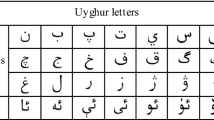Abstract
This paper presents an algorithm for recognizing symbols with textured elements in a graphical document. A region adjacency graph represents the document. The texture symbols are modeled by a graph grammar. An inference algorithm is applied to learn such grammar from an instance of the texture. For recognition, a parsing process is applied. Since documents present distortions, error-correcting rules are added to the grammar.
Access this chapter
Tax calculation will be finalised at checkout
Purchases are for personal use only
Preview
Unable to display preview. Download preview PDF.
Similar content being viewed by others
References
S. Ablameyko. An introduction to interpretation of graphic images, volume TT27 of Tutorial Texts in Optical Engineering, chapter Recognition of cartographic objects, pp. 92–123. SPIE The international society for Optical Engineering, 1997.
D. Antoine, S. Collin, K. Tombre. Analysis of technical documents: The REDRAW system. In H. Baird, H. Bunke, K. Yamamoto, eds.: Structured document image analysis. Springer Verlag (1992) 385–402.
L. Boatto, et al. An interpretation system for land register maps. Computer, 25:25–33, 1992.
H. Bunke. Attributed Programmed Graph Grammars and Their Application to Schematic Diagram Interpretation. IEEE Transactions on PAMI, 4(6):574–582, November 1992.
D. Dori. A syntactic/geometric approach to recognition of dimensions in engineering machine drawings. Computer Vision, Graphics and Image Processing, 1989.
H. Fahmy and D. Blostein. A graph grammar programing style for recognition of music notation. Machine Vision and Aplications 6:83–99, 1993.
L. G. C. Hamey. Computer Perception of Repetitive Textures. PhD thesis, Computer Science Department, Carnegie Mellon University, Pittsburg, 1988.
T. Kasvand. Linear textures in line drawings. In Proc. in the 8th Int. Conf. on Pattern Recognition, 1986.
A. Kosmala, S. Lavirotte, L. Pottier, and G. Rigoll. On-Line Handwritten Formula Recognition using Hidden Markov Models and Context Dependent Graph Grammars. In Proc. of 5th Int. Conf. on Document Analysis and Recognition, 1999.
J. Lladós, G. Sánchez and E. Martí. A string-based method to recognize symbols and structural textures in architectural plans. Graphics Recognition, Algorithms and Systems. K. Tombre and A. K. Chhabra (eds). Lecture Notes in Computer Science, Springer-Verlag, 1389:91–103, 1998.
J. Lladós, E. Martí and J. J. Villanueva. Symbol Recognition by Error-Tolerant Subgraph Matching between Region Adjacency Graphs. IEEE Transactions on PAMI. 23(10):1137–1143, October, 2001.
S. Y. Lu and K. S. Fu. A syntactic approach to texture analysis. Computer Graphics and Image Processing, 7:303–330, 1978.
T. Matsuyama, K. Saburi, and M. Nagao. A structural analyzer for regularly arranged textures. Computer Graphics and Image Processing, 18, 1982.
W. Min, Z. Tang, and L. Tang. Using web grammar to recognize dimensions in engineering drawings. Pattern Recognition, 26(9):1407–1916, 1993.
J. Rekers and A. Schürr. Defining and Parsing Visual Languages with Layered Graph Grammars. Journal of Visual Languages and Computing, 8(1):27–55, London: Academic Press (1997).
G. Rozenberg. Handbook of Graph Grammars and Computing by Graph Transformation. Vol. I, Foundations, World Scientific, 1997.
G. Sánchez, J. Lladós and K. Tombre. A Mean String Algorithm to Compute the Average Among a Set of 2D Shapes. Pattern Recognition Letters. 23(1–3):203–213, January 2002.
Author information
Authors and Affiliations
Editor information
Editors and Affiliations
Rights and permissions
Copyright information
© 2002 Springer-Verlag Berlin Heidelberg
About this paper
Cite this paper
Sánchez, G., Lladós, J., Tombre, K. (2002). An Error-Correction Graph Grammar to Recognize Texture Symbols. In: Blostein, D., Kwon, YB. (eds) Graphics Recognition Algorithms and Applications. GREC 2001. Lecture Notes in Computer Science, vol 2390. Springer, Berlin, Heidelberg. https://doi.org/10.1007/3-540-45868-9_10
Download citation
DOI: https://doi.org/10.1007/3-540-45868-9_10
Published:
Publisher Name: Springer, Berlin, Heidelberg
Print ISBN: 978-3-540-44066-6
Online ISBN: 978-3-540-45868-5
eBook Packages: Springer Book Archive




